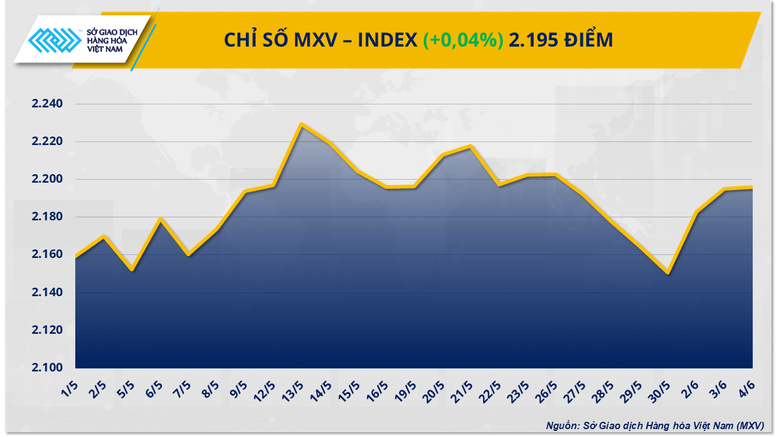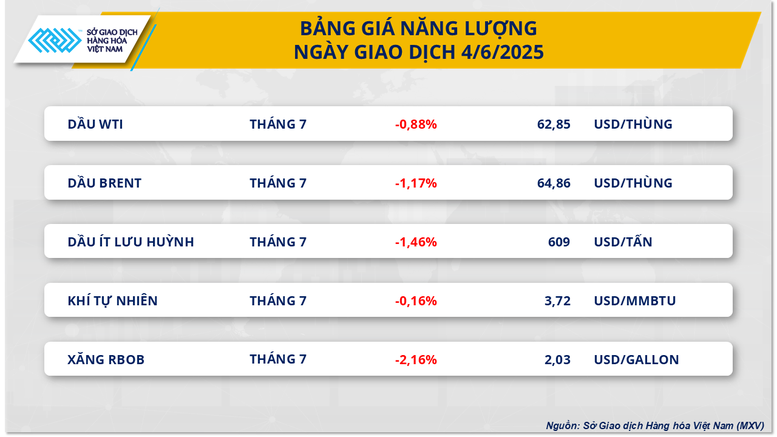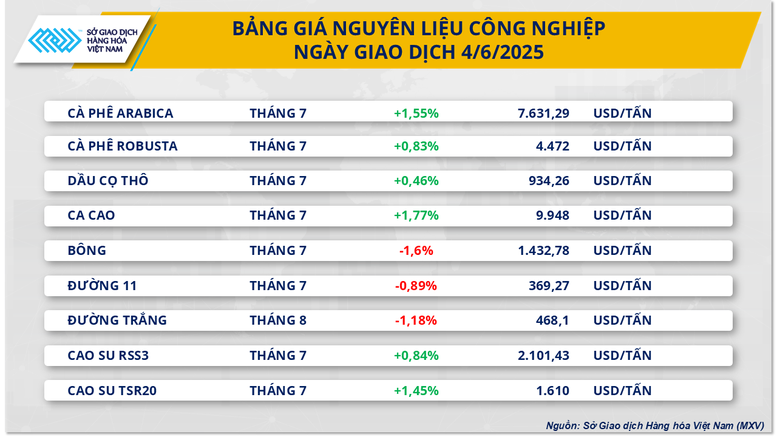
Closing yesterday's trading session, the energy market was covered in red when all 5 commodities in the group simultaneously turned down. In particular, the oil price increase in the previous two trading sessions was also stopped when data from the US Energy Information Administration (EIA) was released.
Closing, Brent oil price fell below the threshold of 65 USD/barrel when it stopped at 64.86 USD/barrel, down about 1.17%. Similarly, WTI oil price also decreased about 0.88%, down to 62.85 USD/barrel.

According to the weekly petroleum status report just released by the US Energy Information Administration (EIA), commercial crude oil inventories in the work week ending May 30 fell by 4.3 million barrels – similar to the American Petroleum Institute (API) estimate of a decrease of about 3.3 million barrels of oil at the end of June 3. However, according to data from EIA, petroleum inventories increased sharply by more than 5.2 million barrels last week, a sign that fuel consumption in the US is at risk of slowing down.
According to Giovanni Staunovo, an expert at UBS bank, this week's EIA report is a negative signal for the oil market. He commented that the strong demand for crude oil from refineries has caused a sharp decline in commercial crude oil reserves, but after the Memorial Day holiday (May 26), the supply of refined products increased sharply while demand weakened, leading to a spike in gasoline inventories. In particular, distillate fuel inventories also increased sharply last week by 4.23 million barrels.
Concerns about US oil demand continued to grow following the latest assessment of the health of the world's largest economy from the US Federal Reserve (Fed). In the Beige Book released yesterday, economic activity in the US has weakened slightly in recent weeks, while the White House's tariff policies have put upward pressure on costs and prices since the last meeting of the Federal Open Market Committee (FOMC). This has made businesses and households more cautious in their consumption decisions, contributing to concerns about domestic fuel demand.
Previously, the Organization for Economic Cooperation and Development (OECD) cut its global economic growth forecast from 3.3% in 2024 to 2.9% in 2025, lower than the 3.1% forecast given in March. The gloomy economic situation in the US in particular and the world in general has increased market concerns about the outlook for oil demand in the coming time.
In addition, oil prices were also pressured by supply as some oil production in Canada was restored yesterday after a period of interruption due to wildfires. In addition, the impact of OPEC+ increasing production by 411,000 barrels/day in July continued to put pressure on global oil prices.

According to MXV, at the end of yesterday's trading session, buying power dominated most key commodities in the industrial raw materials group. However, contrary to the general trend of the group, the prices of two sugar commodities simultaneously weakened. Of which, the price of raw sugar decreased by 0.89% to 369.27 USD/ton, while the price of white sugar also decreased by 1.18%, anchored at 468.1 USD/ton.
The main reason for the sharp drop in sugar prices is that global supply is forecast to increase sharply. Meanwhile, demand for sugar in major markets such as the US is showing signs of weakening.
Source: https://baochinhphu.vn/thi-truong-hang-hoa-the-gioi-dien-bien-giang-co-mxv-index-di-ngang-102250605102912772.htm




























![[Photo] President Luong Cuong works with Hung Yen and Thai Binh Provincial Party Committees on implementing Resolution of the 11th Central Conference, 13th tenure](https://vphoto.vietnam.vn/thumb/1200x675/vietnam/resource/IMAGE/2025/6/6/127b735d2761484d81dcee0d7725a25b)
![[Photo] General Secretary To Lam receives Korean Ambassador to Vietnam](https://vphoto.vietnam.vn/thumb/1200x675/vietnam/resource/IMAGE/2025/6/6/a0765b7543784cbcbfe4755b67d43ab4)



























































![[OCOP REVIEW] Tu Duyen Syrup - The essence of herbs from the mountains and forests of Nhu Thanh](https://vphoto.vietnam.vn/thumb/402x226/vietnam/resource/IMAGE/2025/6/5/58ca32fce4ec44039e444fbfae7e75ec)











Comment (0)